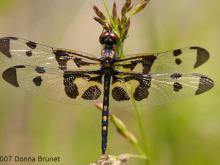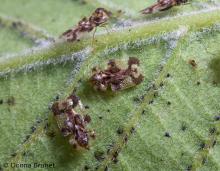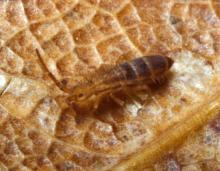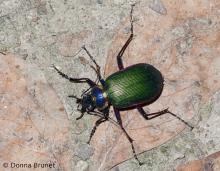Land Invertebrates
Media

Species Types
Scientific Name
Species in the suborder Anisoptera
Description
Like damselflies, dragonflies have long bodies, two pairs of long, membranous, finely veined wings, and predaceous aquatic larvae. Dragonflies typically hold their wings stretched outward, horizontally.
Media

Species Types
Scientific Name
Leucauge venusta
Description
The orchard orbweaver is a small, colorful, greenish, delicate spider that makes circular webs in low bushes and damp woodlands. It typically hangs in the middle of its web, its back to the ground.
Media

Species Types
Scientific Name
Mecaphesa spp. and Misumessus spp.
Description
Foliage flower spiders are two genera of crab spiders. They are generally smaller than other crab spiders, and their carapaces, abdomens, and legs are spiny.
Media

Species Types
Scientific Name
Lepisma saccharina, Thermobia domestica, and other species
Description
Silverfish are known worldwide, since they commonly live in our homes. There are a number of species in this family of insects, including the common silverfish and the firebrat.
Media

Species Types
Scientific Name
Verrucosa arenata
Description
In late summer and fall, woodland hikers can count on walking into the arrowhead spider's web. These webs are delicate circles that help the spider snare tiny flying insects.
Media

Species Types
Scientific Name
Micrathena spp.
Description
Missouri has three species of spiny orbweavers in genus Micrathena. The webs of these woodland spiders are often run into by hikers!
Media

Species Types
Scientific Name
About 165 species in North American north of Mexico
Description
Grayish, small, flattened, and rectangular, lace bugs have a lacy network of ridges on the wings and body. They suck nutrients from foliage with their beaks. The resulting pale spots on leaves might be the first sign of their presence.
Media

Species Types
Scientific Name
More than 8,000 species globally
Description
Springtails, like insects, have six legs, but these tiny rounded, oval, or elongated creatures that hop quickly into the air are not insects. They have a separate lineage and many structural differences.
Media

Species Types
Scientific Name
Species in the suborder Zygoptera
Description
Like dragonflies, damselflies have long bodies, two pairs of long, membranous, finely veined wings, and predaceous aquatic larvae that have extendible mouthparts. Damselflies typically hold their wings together, above the body.
Media

Species Types
Scientific Name
About 2,400 species in North America north of Mexico
Description
Ground beetles are a family of mostly nocturnal or light-shunning beetles that tend to be shiny black and have grooved wing covers. This group also includes tiger beetles, however, which includes many colorful daytime fliers.
See Also



Media

Species Types
Scientific Name
Cisseps fulvicollis
Description
The yellow-collared scape moth is more often “orange-collared.” And whether you think it looks more like a firefly or a wasp, it’s still a moth!
Media

Species Types
Scientific Name
Nearly 150 species in North America north of Mexico
Description
Slim, delicate plume moths are instantly recognizable by their T-shaped silhouette, long legs, and muted shades of tan and brown. It can be hard to separate the various species.
Media

Species Types
Scientific Name
Pyrrharctia isabella
Description
Not many people know the adult Isabella tiger moth when they see one, but we’re all acquainted with its caterpillar, the woolly worm, or woolly bear.
About Land Invertebrates in Missouri
Invertebrates are animals without backbones, including earthworms, slugs, snails, and arthropods. Arthropods—invertebrates with “jointed legs” — are a group of invertebrates that includes crayfish, shrimp, millipedes, centipedes, mites, spiders, and insects. There may be as many as 10 million species of insects alive on earth today, and they probably constitute more than 90 percent all animal species.





















